
Explore the Gentle Path: A Beginner Guide to Yin Yoga
Welcome to the gentle world of Yin Yoga, where relaxation and rejuvenation are at the heart of every practice. In this comprehensive yin yoga for beginners guide, we will delve into the fundamentals of Yin Yoga so you can unlock its many benefits and develop a deeper understanding of this ancient practice.
Unlike its more dynamic counterparts, Yin Yoga focuses on long, passive holds and works deep into the connective tissues, targeting the joints and fascia. By surrendering to stillness and exploring gentle poses for an extended period, you can experience a profound release of tension and a heightened sense of peace.
Moreover, throughout this guide, we will discuss the fundamental principles of Yin Yoga, including its philosophy, specific poses, and breathing techniques. Whether you are a seasoned yogi looking to widen your practice or a beginner seeking relaxation and flexibility, this guide is tailored to meet your needs.
Join us as we embark on a journey of self-discovery and delve into the gentle path of Yin Yoga. Get ready to embrace the tranquility and experience the transformative power of this meditative practice.
What is Yin Yoga?
Yin Yoga is a slow-paced, meditative kind of yoga focusing on long-held poses designed to work on the body's deep connective tissue and tissues. Unlike more dynamic types of yoga, Yin Yoga involves passive stretching and also requires practitioners to hold poses for an extended period, typically ranging from one to five minutes.
The practice of Yin Yoga is rooted in the principles of Chinese Taoist philosophy, which emphasizes the balance between Yin and Yang energies. Yin represents stillness, darkness, and femininity, while Yang represents movement, light, and masculinity. Yin Yoga also aims to cultivate the Yin aspects within us, allowing for a more profound sense of relaxation, surrender, and introspection.
Understanding the Principles of Yin Yoga
To fully embrace the practice of Yin Yoga for beginners poses, it is also essential to understand its fundamental principles. The first principle is finding your edge, which means finding a point of sensation in a pose that is intense yet manageable. It is essential to avoid pushing too far beyond your limits, as this can lead to injury. Instead, focus on gentle exploration and gradual progression.
The second principle is surrendering to stillness. Unlike other active forms of yoga, Yin Yoga invites practitioners to remain in poses for an extended period without fidgeting or adjusting. This stillness allows for a more profound release of tension and greater relaxation. Finding a balance between effort and ease is vital, as you should never feel pain or discomfort in a Yin pose.
The final principle is holding poses for an extended period. This is what sets Yin Yoga apart from other styles of yoga. Holding poses for a longer duration, typically one to five minutes, allows the connective tissues to release and lengthen gradually. Remember to breathe deeply and consciously throughout the pose, allowing the breath to guide you deeper into relaxation.
What are the Five Elements of Yin Yoga?

Yin Yoga is a gentle and contemplative practice emphasizing the prolonged holding of yoga poses. It incorporates the principles of Traditional Chinese Medicine, including the concept of the five elements. These elements are Water, Wood, Fire, Earth, and Metal. Each element is associated with different seasons, emotions, biological functions, and organs. We can also support our entire health and well-being by understanding and working with these elements in our yin yoga poses and practice. Beginners need to familiarize themselves with these elements and how they relate to the body to fully benefit from their yin yoga poses and practice.
What is the Starting Pose?
In Yin Yoga, the initial pose for beginners can differ based on an individual's comfort level and flexibility. However, there are a few common starting poses that are often recommended. Here are a few foundational Yin Yoga poses to get you started:
- Child's Pose (Balasana) Child's Pose is a resting yoga pose that is often used as a resting position during a yoga practice. It's a relaxing and gentle stretch for the back, hip flexors, and thighs.
- Dragon Pose (Yin Yoga) Dragon Pose is a lunge position variation commonly practiced in Yin Yoga.
- Butterfly Pose (Baddha Konasana) Butterfly Pose, also known as Bound Angle Pose, involves sitting on the floor with the soles of your right and left foot together and your knees bent outward to the sides, resembling the shape of butterfly wings.
In addition, remember to approach these poses with a sense of curiosity and mindfulness. Listen to your body and then make adjustments to ensure a comfortable and safe practice.
Can Beginners Do This Yoga?
Yes, beginners can do Yin Yoga. It is a passive form of yoga that centers on the deep connective tissues within the body. It involves holding poses for extended periods, usually 1-5 minutes or longer. Yin Yoga improves flexibility, promotes relaxation, lowers stress and anxiety, increases body circulation, and also releases fascia. It is a complementary practice to more intense forms of yoga like Vinyasa or Power Yoga. For beginners, specific Yin Yoga sequences and poses are great for increasing flexibility, decreasing stress, and also improving range of motion. Props such as blocks, blankets, and bolsters can make the poses more comfortable. Beginners must also consult a doctor and practice with a certified yoga teacher to ensure proper alignment and safety. By incorporating Yin Yoga for beginners into their practice, you can experience the benefits of this gentle and calming style of yoga.
Benefits of Yin Yoga

Yin Yoga sequence offers a myriad of benefits for both the body and the mind. Physically, the long holds in Yin pose target the deeper tissues and layers of connective tissues, such as ligaments, tendons, and fascia. This type of deep stretching helps to improve flexibility, increase joint mobility, and also release tension in the body.
Beyond the physical and energetic benefits, Yin Yoga also profoundly impacts the mind and emotions. The slow, meditative nature of the practice encourages practitioners to cultivate mindfulness and present-moment awareness. Practitioners can also develop self-awareness and acceptance by surrendering to stillness and observing bodily sensations.
Additionally, Yin Yoga is recognized for its ability to soothe the nervous system, thereby diminishing stress and anxiety levels. The practice activates the parasympathetic nervous system, also known as the rest and digest response, which aids the nervous systems in counterbalancing the effects of the sympathetic nervous system, responsible for the fight-or-flight response.
How to Perform a Yin Yoga Stretch
You shouldn't expect to be inversions, arm balances, and other vigorous postures, as these are not included in yin yoga. However, many people report increased flexibility and mobility after practicing deep stretches in yin yoga regularly, even if they don't notice it immediately. You can perform a yin yoga stretch while lying or sitting on a chair or bench in a quiet room. You want to avoid distractions that may cause you to lose focus on your breathing and the stretch itself. Once you have found a comfortable position, focus on your breath and make it flow naturally. Take slow, deep breaths, and try to slowly release any built-up tension in your muscles as you exhale.
Warm Up
1. Breaths
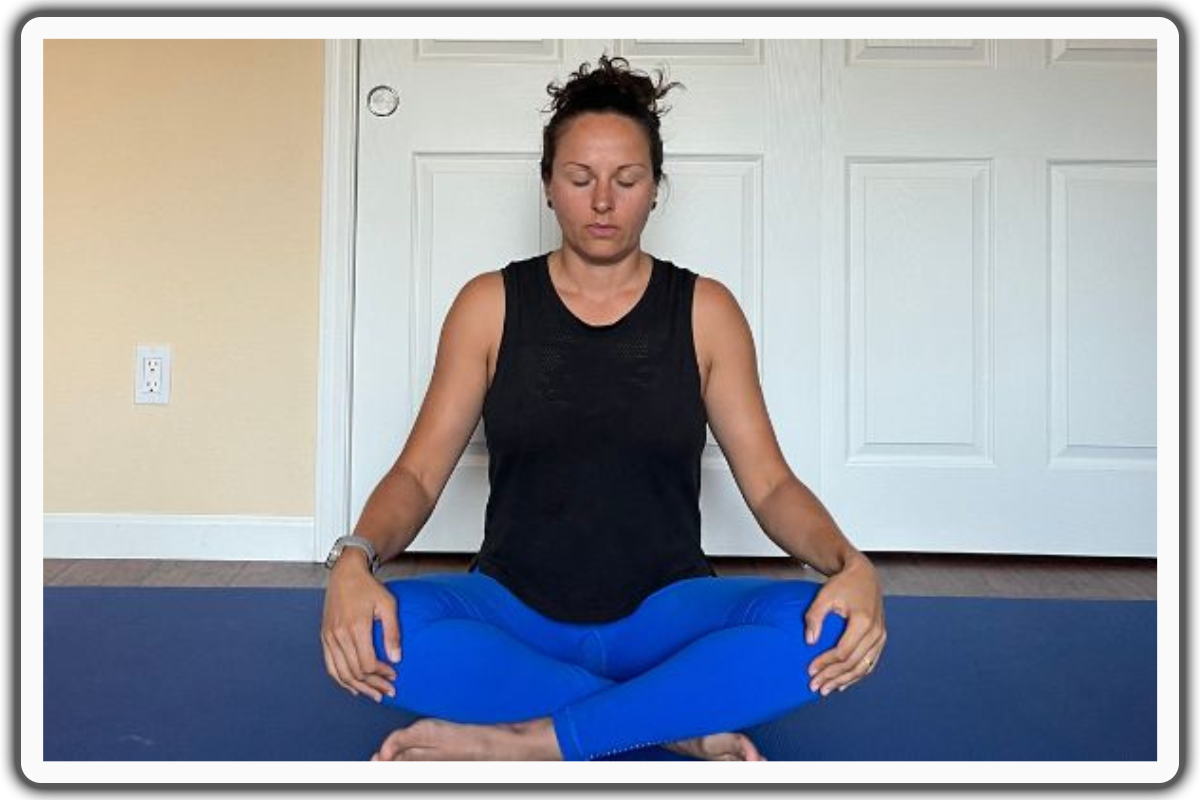
Use a bolster, pillow, or folded blanket to make a comfortable seat for this exercise.
Begin in an upright sitting position on the bolster with your legs crossed in front of your body, maintaining good alignment with your head, shoulders, and hips. Place your hands on your knees. Close your eyes and hold this position for several deep belly breaths, in through your nose and then out through your mouth.
2. Wrist Circles
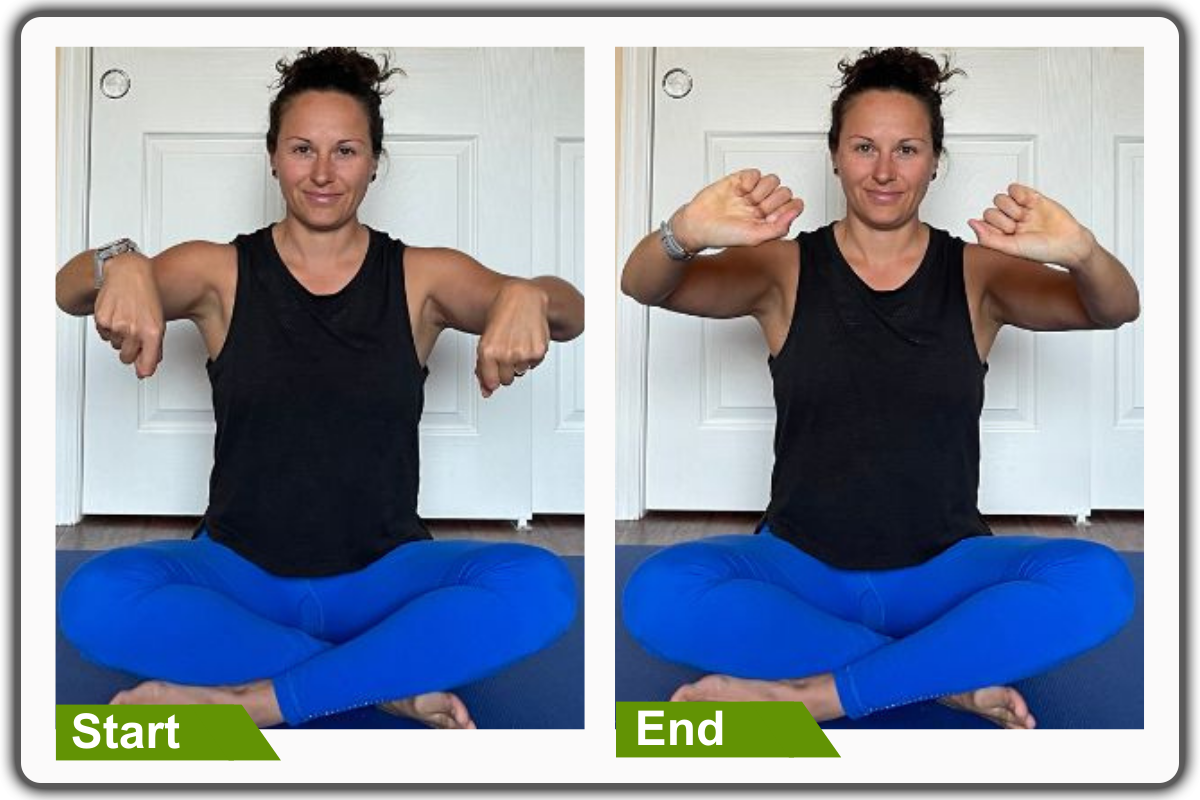
Begin in an upright sitting position with your legs crossed in front of your body, maintaining good alignment with your head, shoulders, and then hips. Lift both hands to head level and start circling your right and left wrist from one direction to the other. Repeat the movement for several deep belly breaths.
3. Wrist Stretch
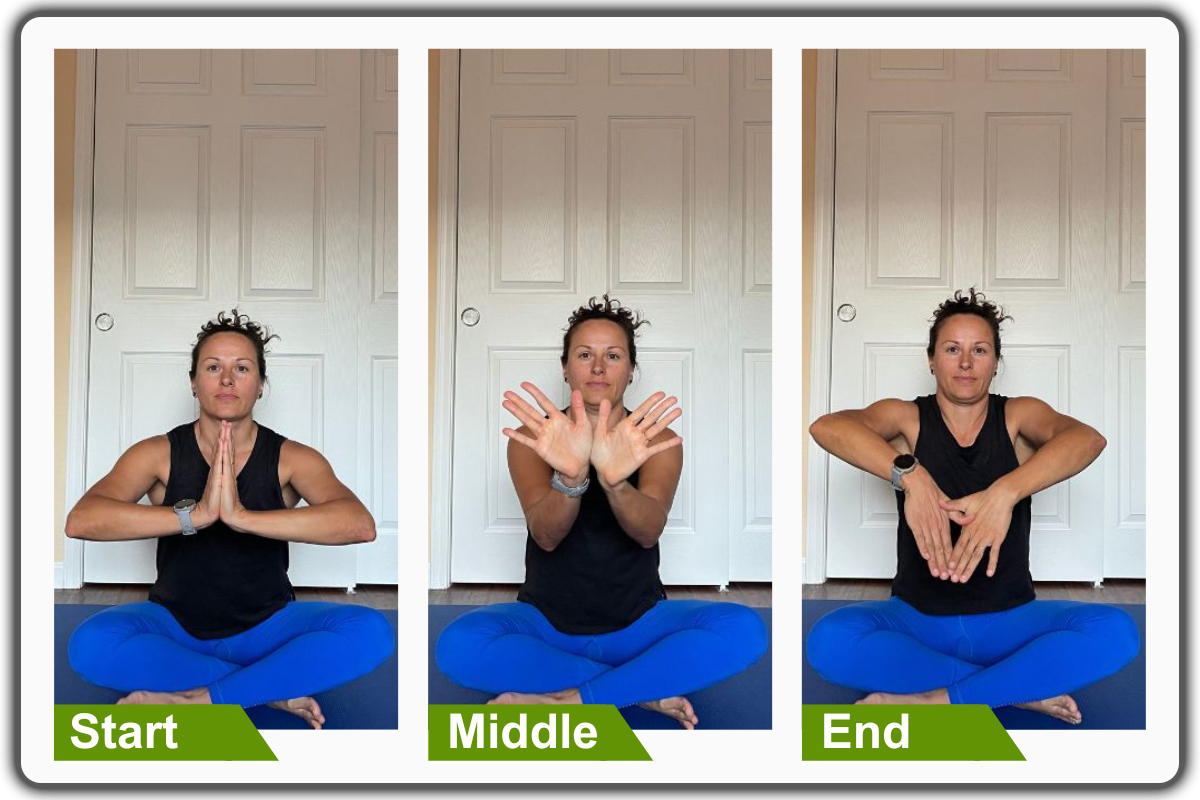
Firstly, begin in an upright sitting position on the floor with your legs crossed in front of you. Maintain good alignment of your head, shoulders, and hips. Interlace your fingers at your heart center and push your hands forward, palms facing outward. Secondly, reach your arms out as much as possible and drop your head, arching your back. Hold this position for several deep belly breaths. Lastly, slowly move your arms up and bend your head backward. Take several deep belly breaths and then return to the starting position.
4. Arm Stretch
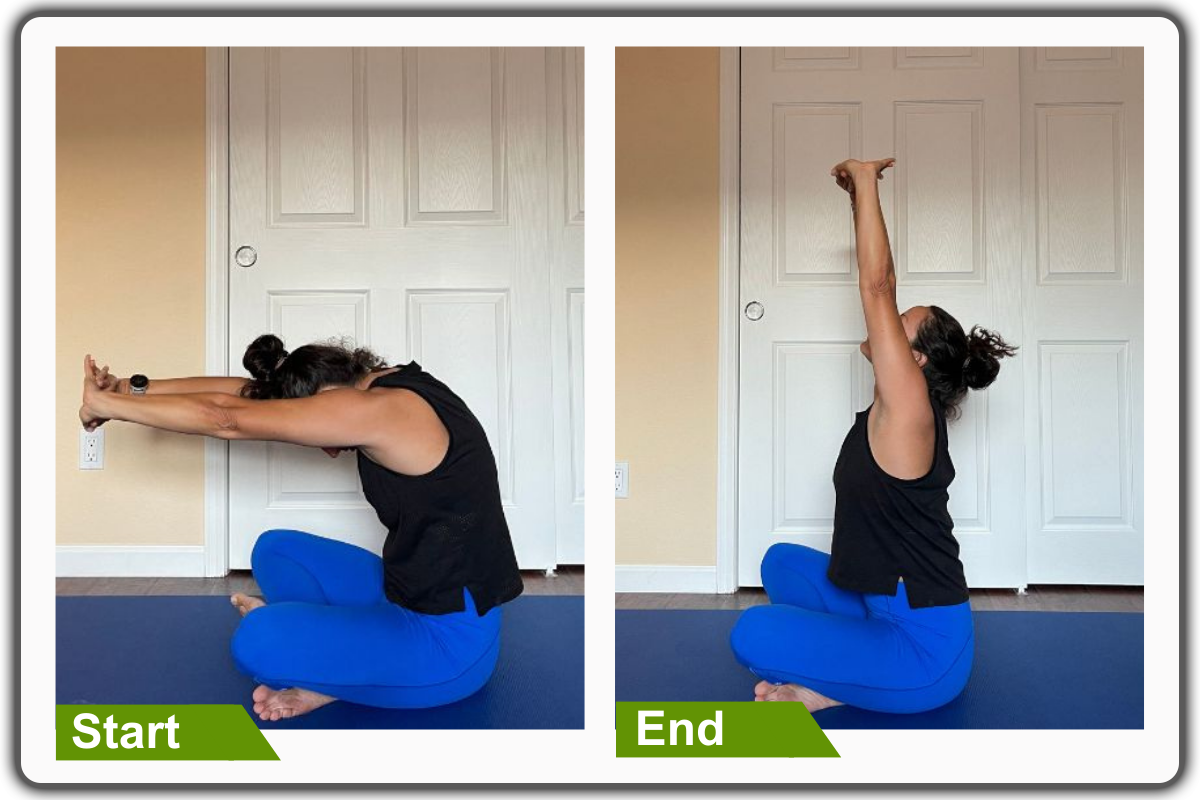
Begin in an upright sitting position with your legs crossed in front of your body, maintaining good alignment with your head, shoulders, and hips. Extend your arms in front of your body below shoulder height and interlace your fingers with your palms facing away from your body. Tighten your core and pull your arms forward as you drop your chin down towards your chest, rounding out your midback. Hold this position for several deep belly breaths. Slowly move your arms up and bend your head backward. Take several deep belly breaths and then return to the starting position.
Routines
1. Cross-Legged Forward Fold
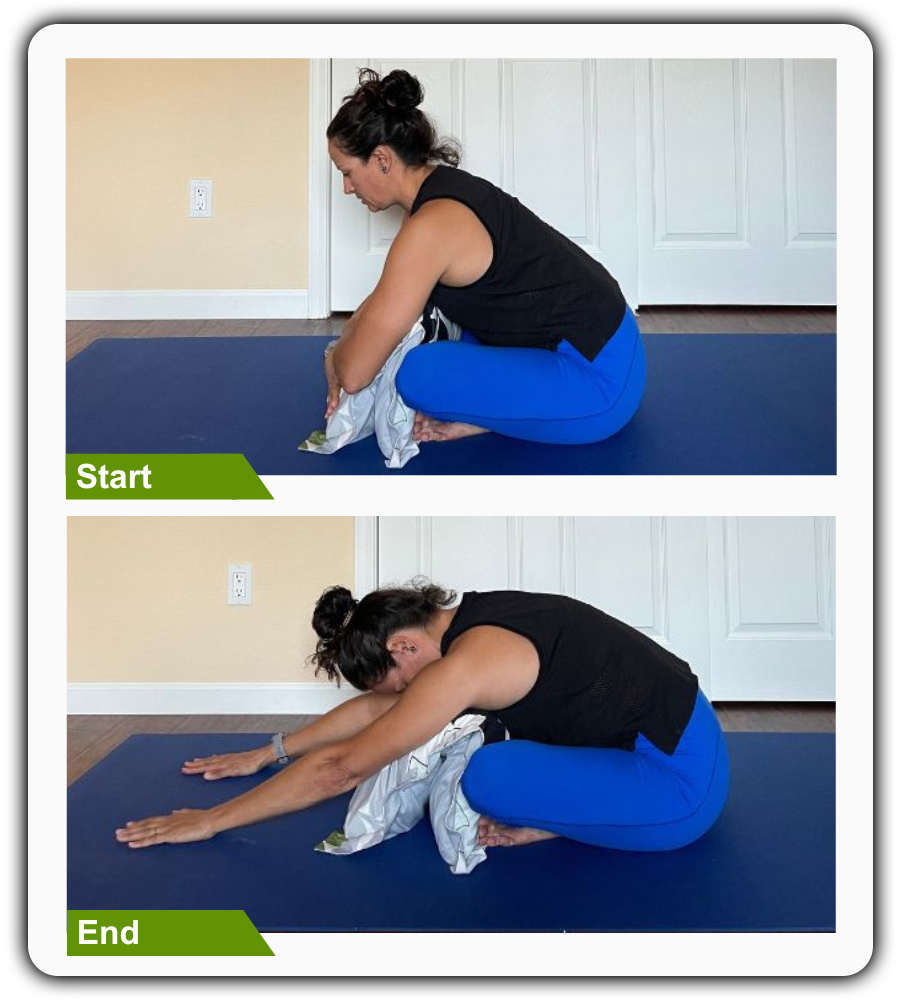
For this exercise, use a bolster, a pillow, or a stack of books for support.
Begin in an upright sitting position in front of a bolster or pillow with your legs crossed in front of your body, maintaining good alignment with your head, shoulders, and hips. Tighten your abdominal area and hinge from your hips to bend your upper body forward, resting your upper body on the pillow. Extend your arms straight in front of your body, planting your palms flat on the floor. Lower your head down, relaxing your mid-back area for a light stretch. Hold this position for several deep belly breaths and then return to the seated position again.
In addition to intensify this yin yoga for beginners movement, stretch your back more by moving your hands forward.
Variation 1 - Cross-Legged Forward Fold
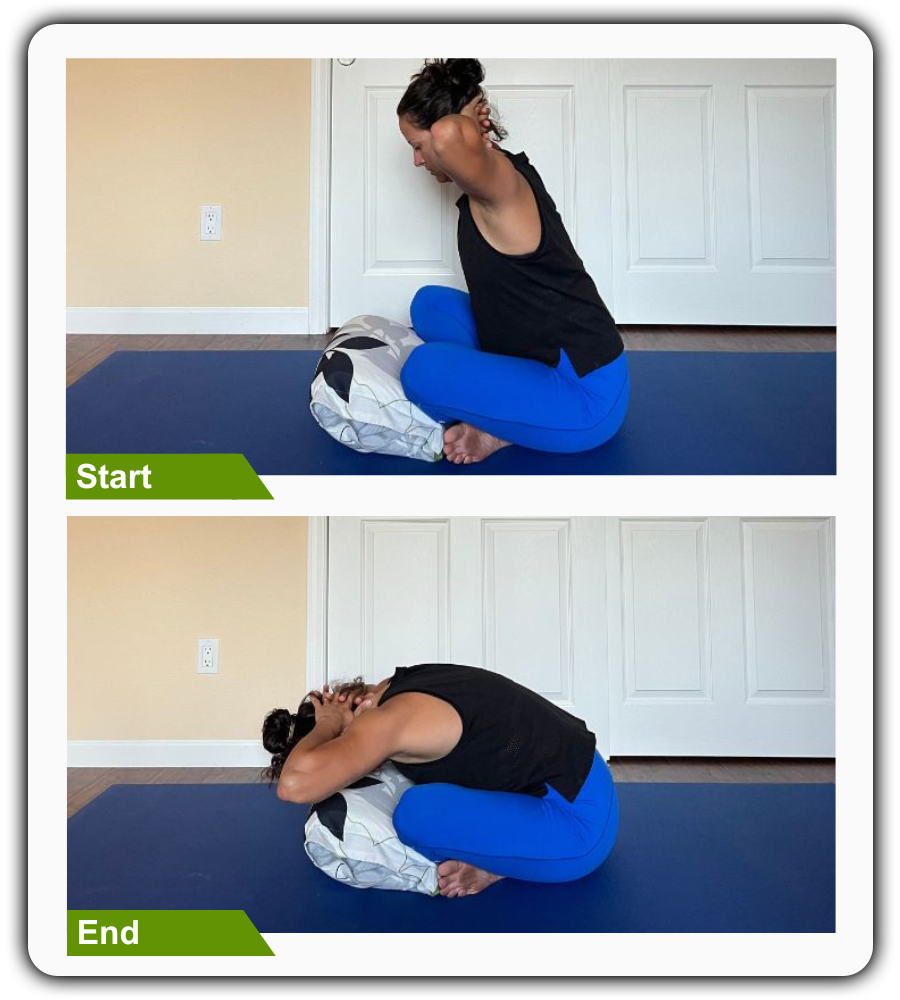
For this exercise, use a bolster, a pillow, or a stack of books for support.
Firstly, begin in an upright sitting position in front of a bolster or pillow with your legs crossed in front of your body, maintaining good alignment with your head, shoulders, and hips. And then, place a bolster on the floor in front of your body and a pillow on your thighs. Secondly, interlace your fingers and put them behind your head and upper neck. Tighten your abdominal area and hinge from your hips to bend your upper body forward, resting your upper body on the pillow. Lastly, pull your neck down gently, relaxing your mid-back area for a light stretch. Hold this position for several deep belly breaths and then return to the starting position.
2. Neck Stretch
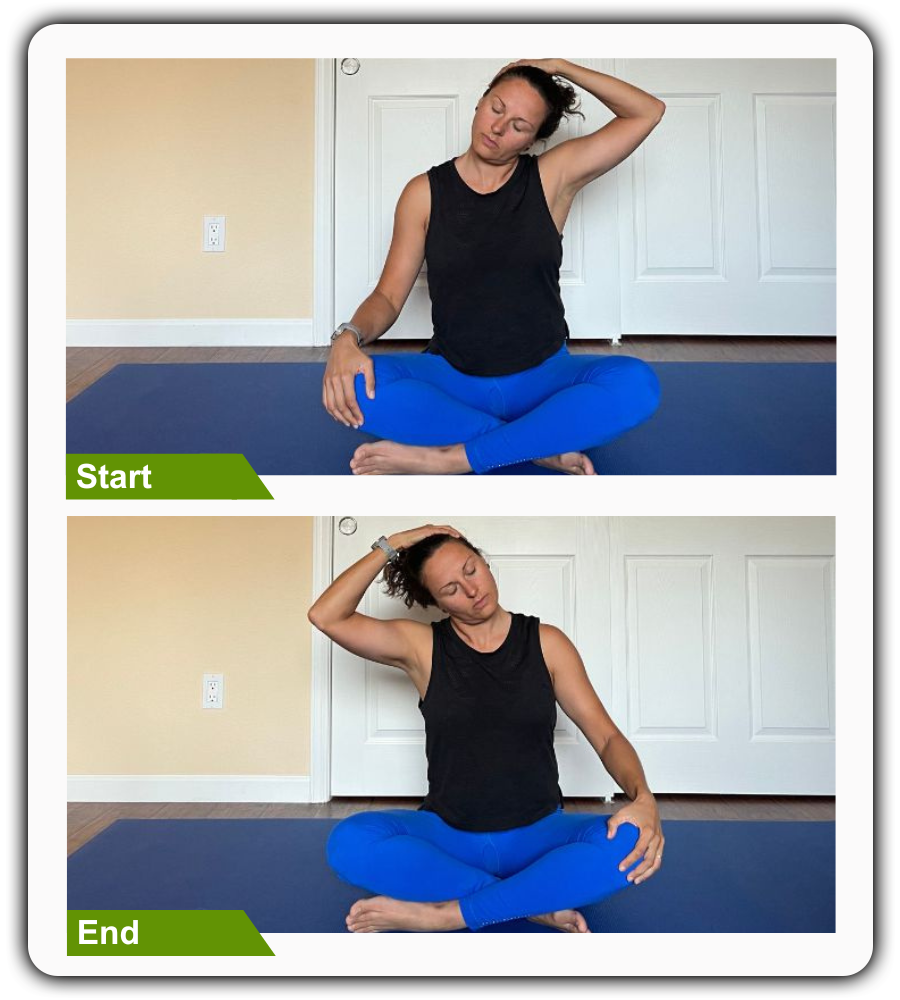
Begin in an upright sitting position on the floor with your legs crossed in front of you, maintaining good alignment with your head, shoulders, and hips. Place your hands on your knees. Bring your left hand to your right ear. Inhale and engage your core. Slightly extend your neck and, on your exhale, slowly pull your head to the left until you feel the resistance. Hold this position for several deep belly breaths. Return to the starting position and then repeat the movement on the opposite side.
Place your left hand behind your right foot or hip and vice versa to intensify this movement.
Variation 1 - Neck Stretch
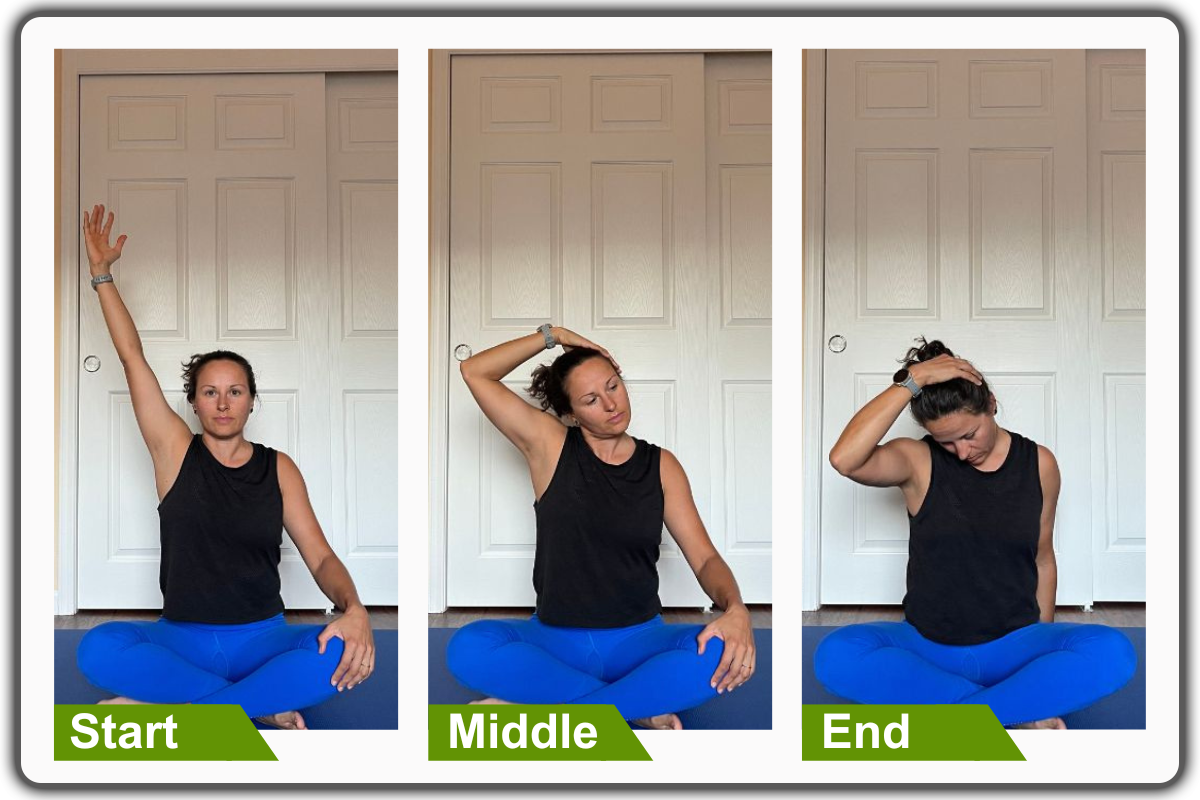
Begin in an upright sitting position on the floor with your legs crossed in front of you, maintaining good alignment with your head, shoulders, and hips. Place your hands on your knees and engage your core. Raise your right hand and bring it at a 45-degree angle from the body. Then, lower that same hand behind your head. Slightly extend your neck and, on your exhale, slowly pull your head down until you feel the resistance. Hold this position for several deep belly breaths. Return to the starting position and switch sides.
3. Child’s Pose
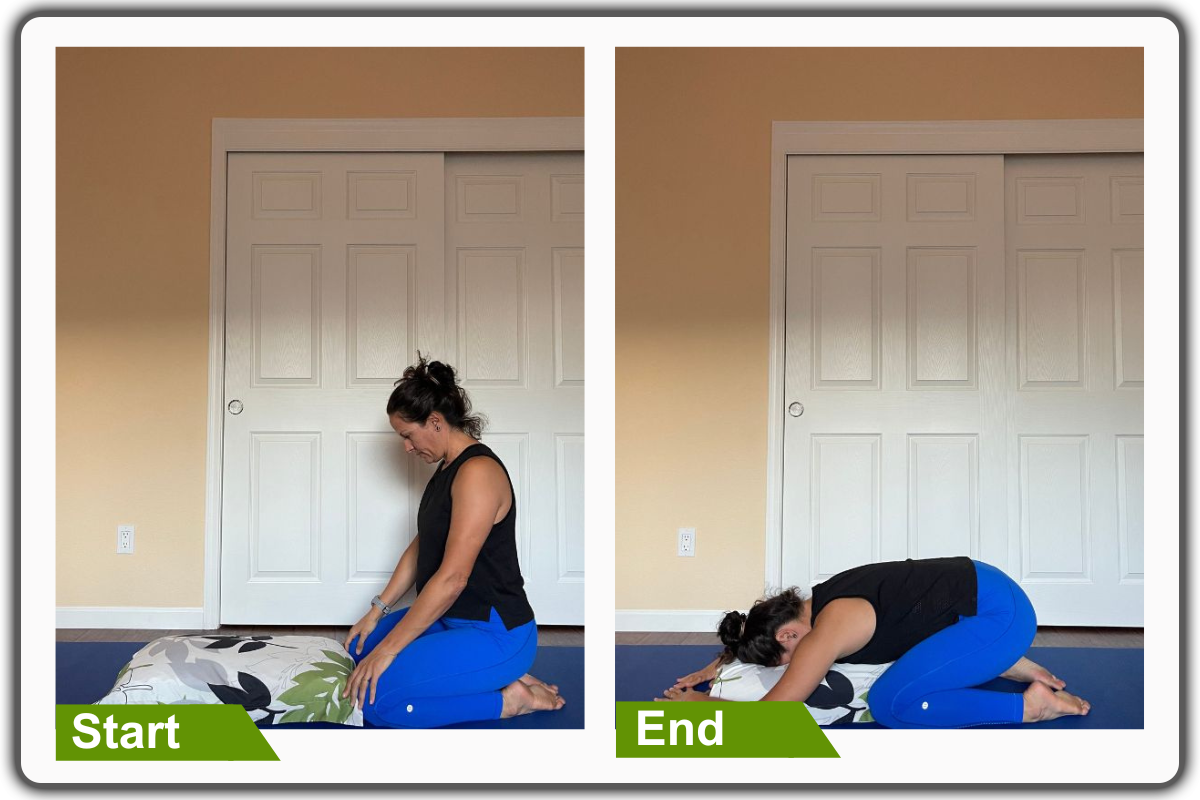
For this yin yoga for beginners exercise, you can use a pillow, folded blanket, bolster, cushion, or a yoga block for support.
Begin in an upright kneeling position in front of a pillow with your knees wider than shoulder-width apart. Engage your core and shift your hips back to your feet, wrapping both arms around the pillow. Lower your forehead on the pillow for proper blood flow, and relax your midback area for a light stretch. Hold this position for several deep belly breaths and then return to the starting position.
4. Butterfly
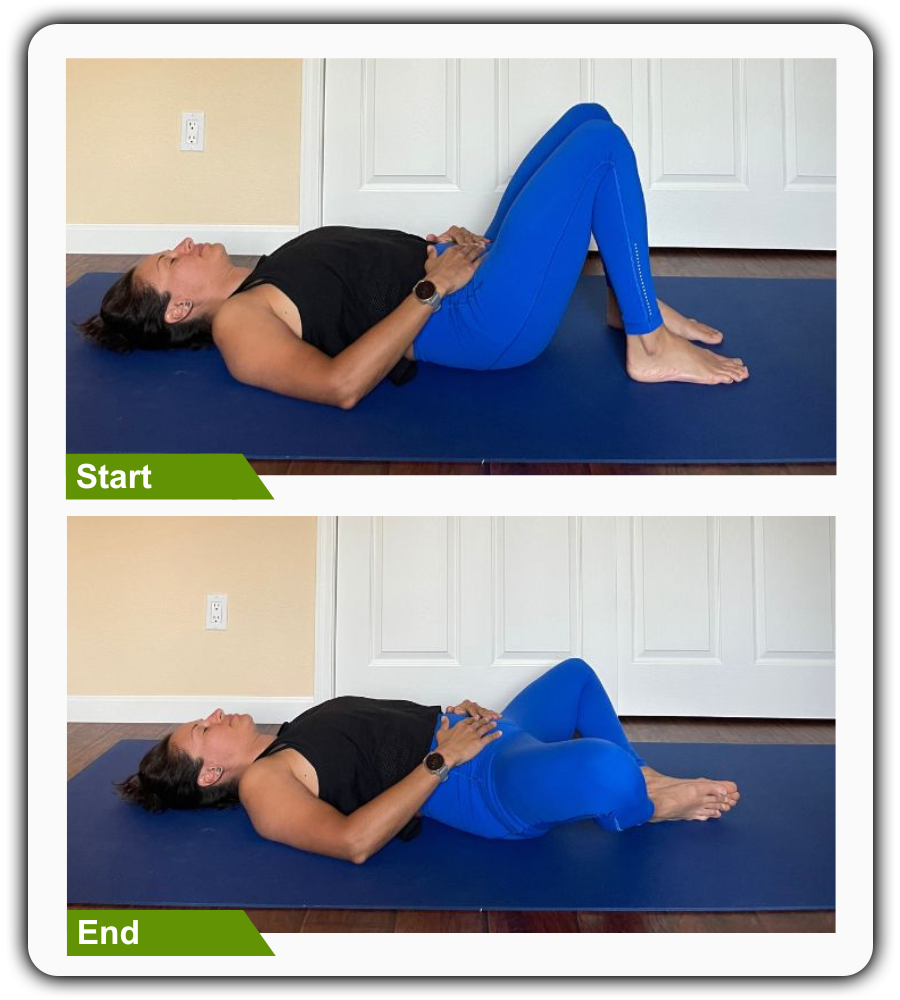
For this exercise, you can use a pillow, folded blanket, bolster, cushion, or a yoga block underneath each knee for support if needed.
Lie on your back on the floor with your knees bent and feet flat on the floor, relaxing your upper body. Place your hands on your belly. Bring the soles of your feet together, tighten your core, and open your knees out to the sides. Hold this position for several deep belly breaths, in through your nose and then out through your mouth.
Furthermore, to intensify this exercise, gently rock both your right and left knee from side to side or sit upright and move both knees in circular motions.
5. Knees to Chest
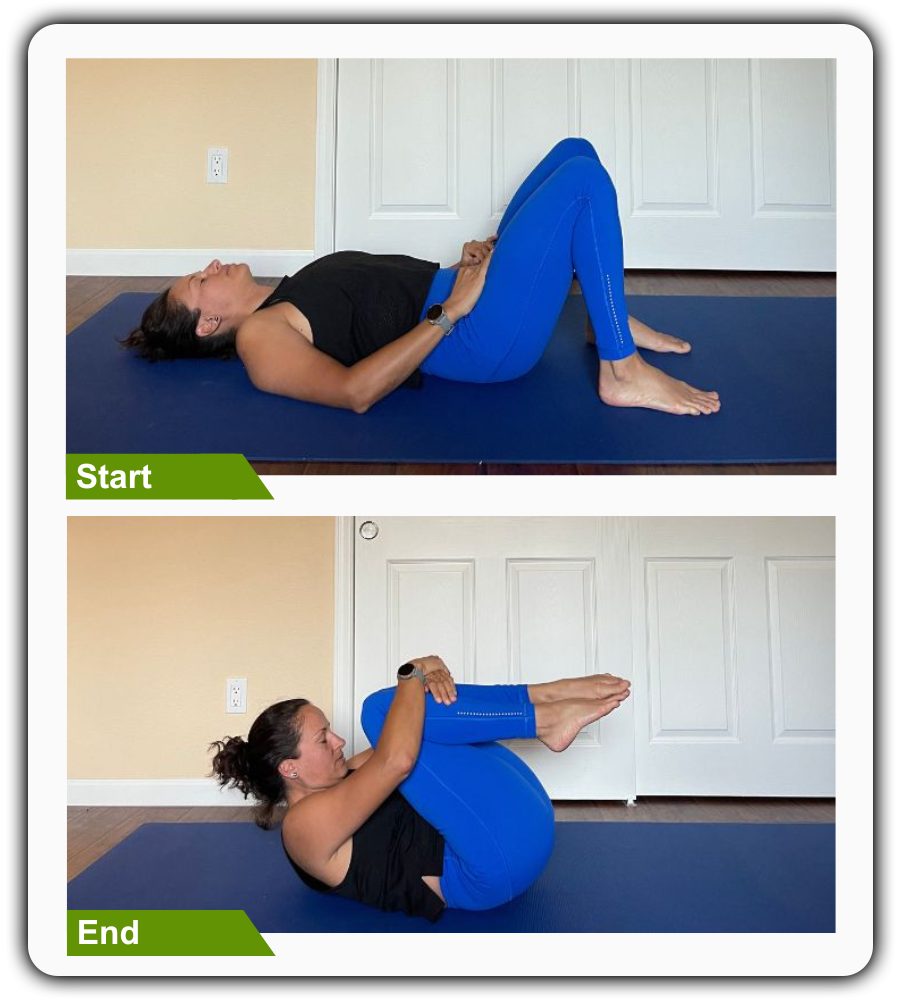
Lie on your back with your knees bent and feet flat on the floor. Engage your core. Bring both knees up to your chest and grab your knees with both arms for a light stretch in the lower back and glutes. Then, lift your head towards your knees to intensify this movement. Hold this position for several deep belly breaths, in through your nose and then out through your mouth. Return to the starting position.
To intensify this exercise, gently rock from side to side or move your knees in circular motions.
6. Happy Baby
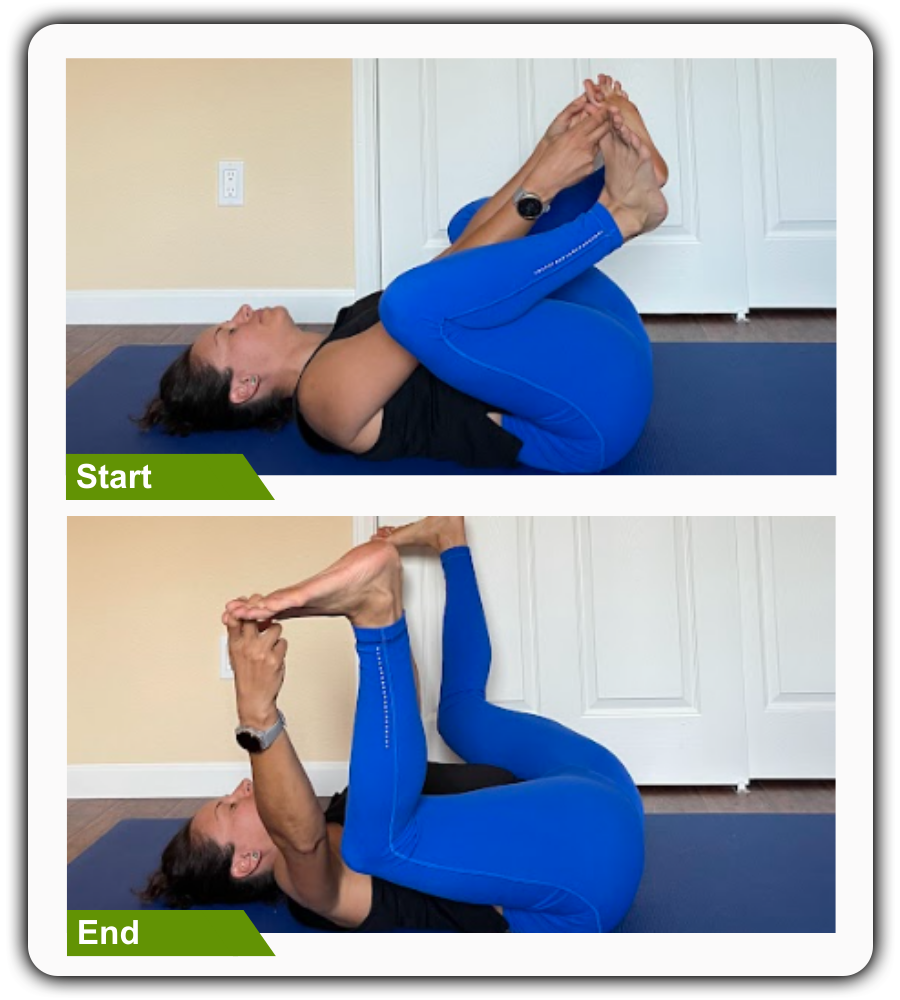
Firstly, lie on your back with your knees bent and feet flat on the floor, relaxing your upper body. Engage your core. Secondly, lift your legs to bring your knees toward your shoulders and wrap two fingers around the insides of your big toes. Lastly, hold this position for several deep belly breaths, in through your nose and out through your mouth. Relax and return to the starting position.
Moreover, to intensify this yin yoga for beginners stretch, pull your feet closer to your body as the final resting pose. Depending on your comfort level, lift and extend one leg out to the side, following with the opposite leg, or extend both legs out and gently rock your body from side to side.
7. Single Knee to Chest
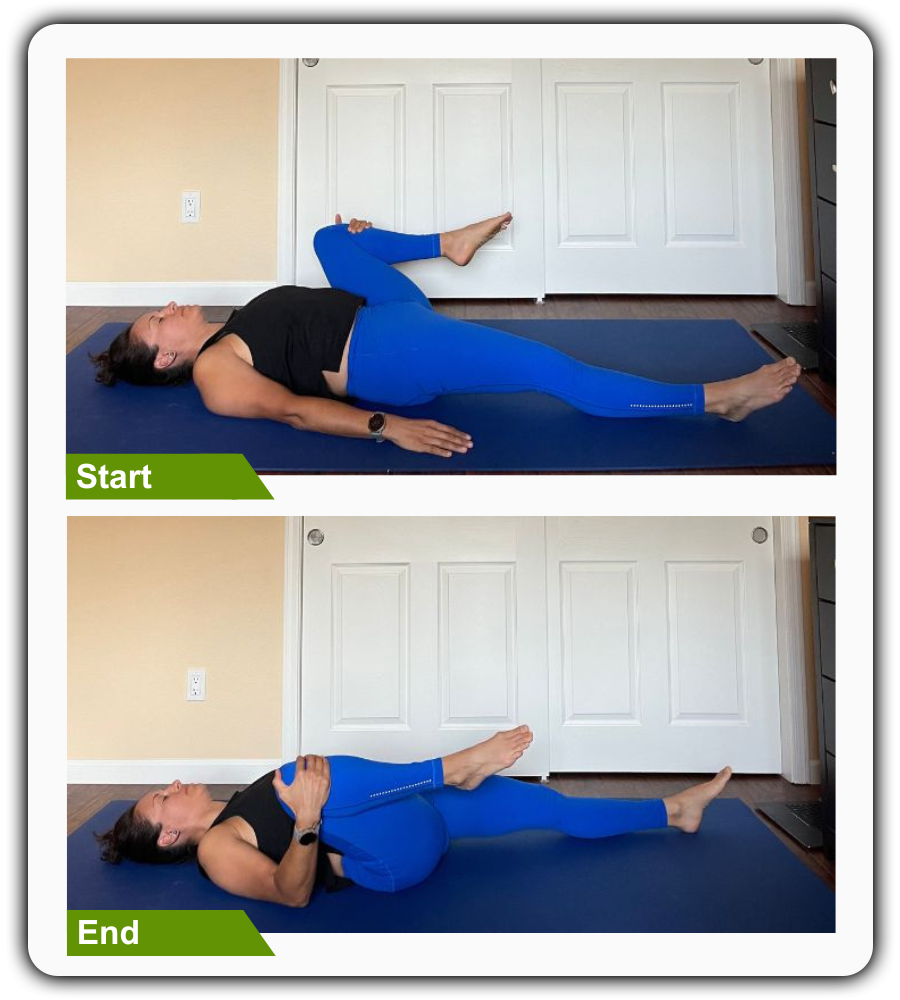
Lie on your back on the floor, maintaining good alignment with your head, shoulders, hips, and legs. Tighten your abdominal area, bend one knee, and use your hands to pull it towards your chest. Look for a light stretch in the hips and lower back. Hold this position for several deep belly breaths. Return to the starting position and then repeat the movement on the opposite side.
8. Frog Pose
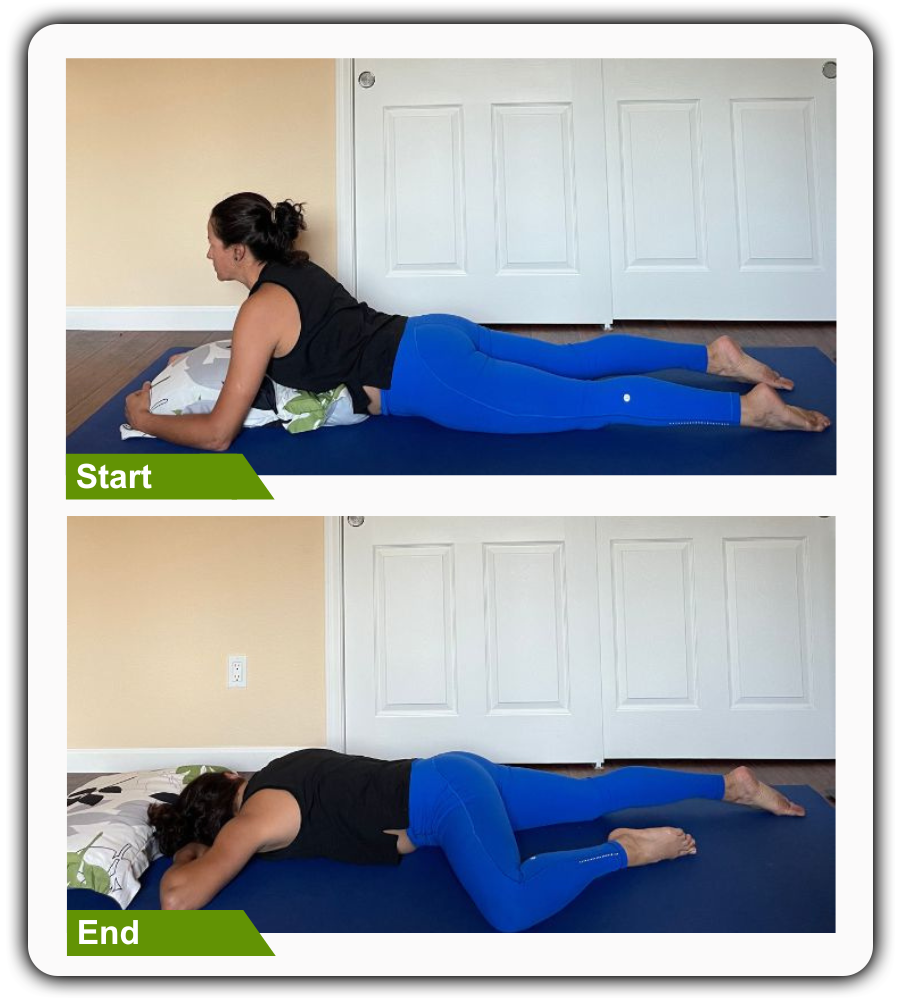
For this yin yoga for beginners exercise, use a folded blanket or a pillow for support.
Lie on your stomach with your feet shoulder-width apart, maintaining good alignment with your head, shoulders, hips, and legs. Bend one knee out to the side, bringing your leg to 90-degress angle. Rest your forehead on the floor or a pillow for support if needed. Hold this position for several deep belly breaths. Return to the starting position and then repeat the movement on the opposite leg.
Variation 1 - Frog Pose
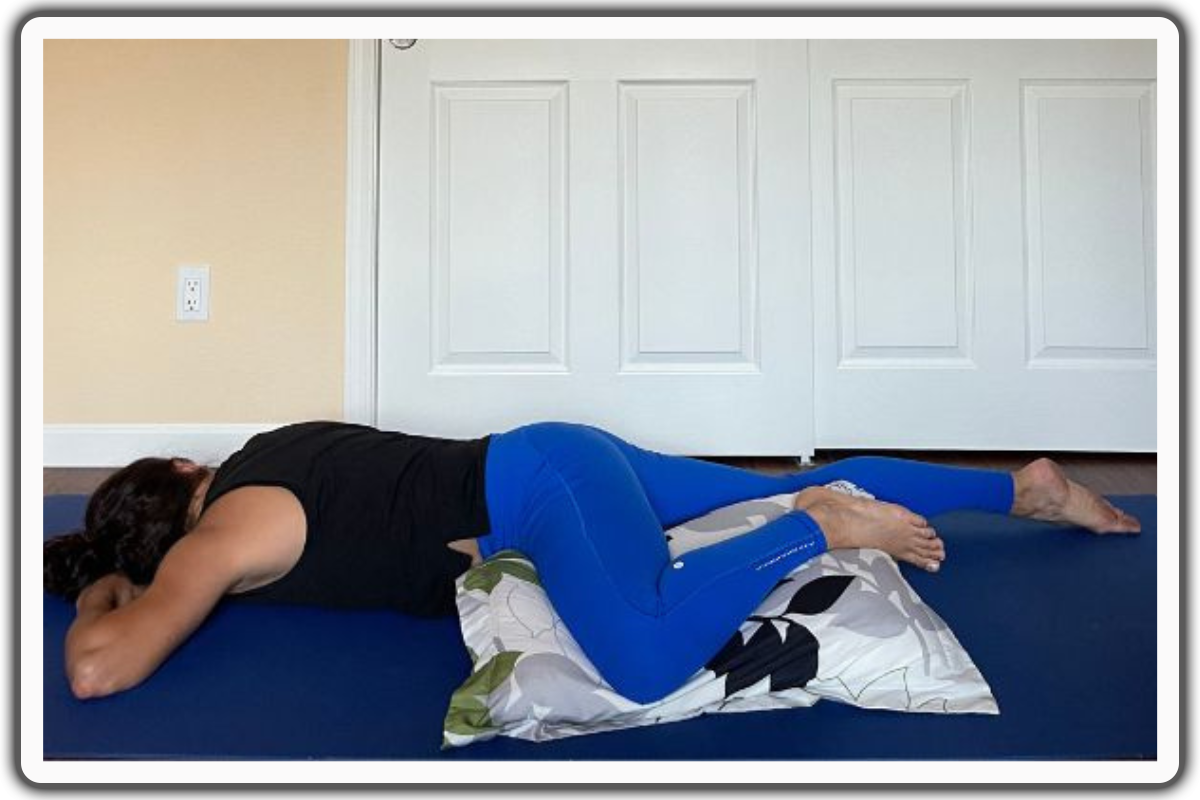
For this yin yoga for beginners exercise, use a pillow or bolster for support if needed.
Lie on your stomach with your feet shoulder-width apart, maintaining good alignment with your head, shoulders, hips, and legs. Bend one knee out to the side, bringing your leg to a 90-degree angle. Place a pillow underneath your bent knee for support if needed. Rest your forehead on the floor or resting one ear down on your arms. Hold this position for several deep belly breaths, in through your nose and then out through your mouth. Relax and repeat the movement on the opposite side.
Cool Down
1. Corpse Pose
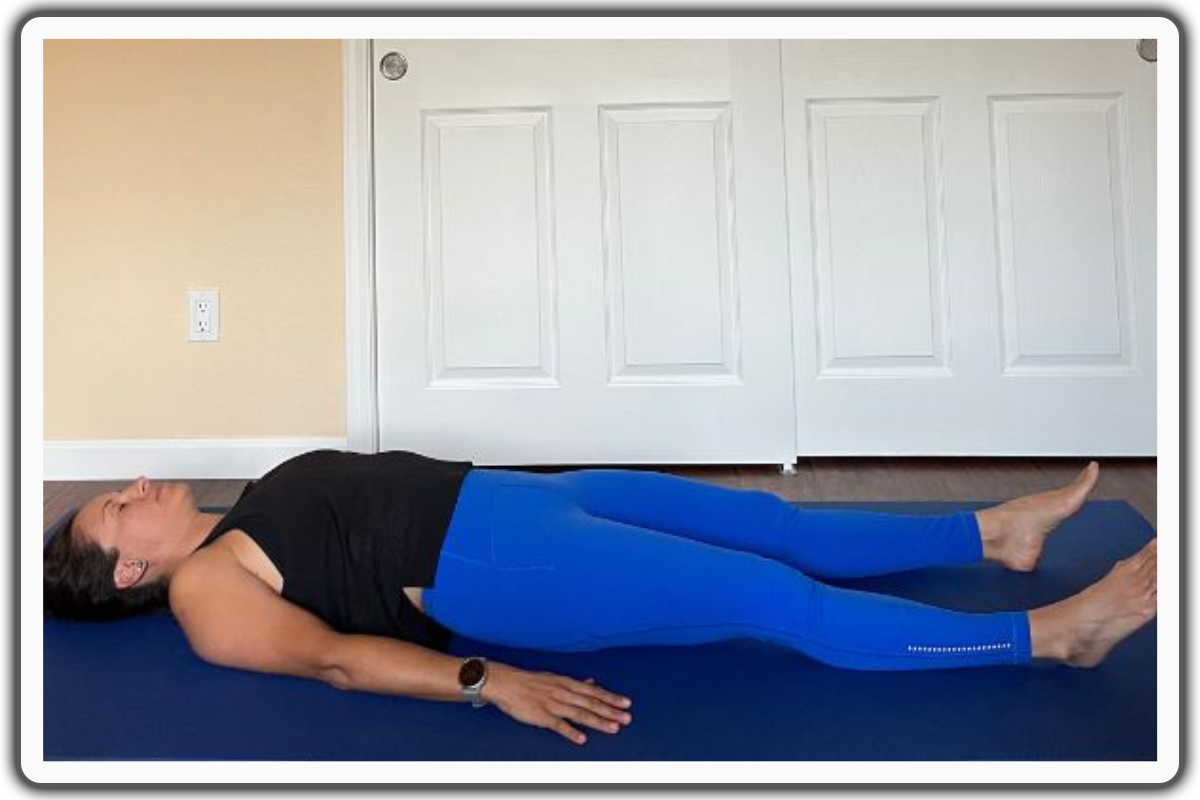
Lie on your back on the floor, maintaining good alignment with your head, shoulders, hips, and legs. Extend your arms out at your sides with your palms facing upward. Close your eyes and relax your entire body. Hold this position for several deep belly breaths, in through your nose and out through your mouth.
2. Arms & Legs Stretch
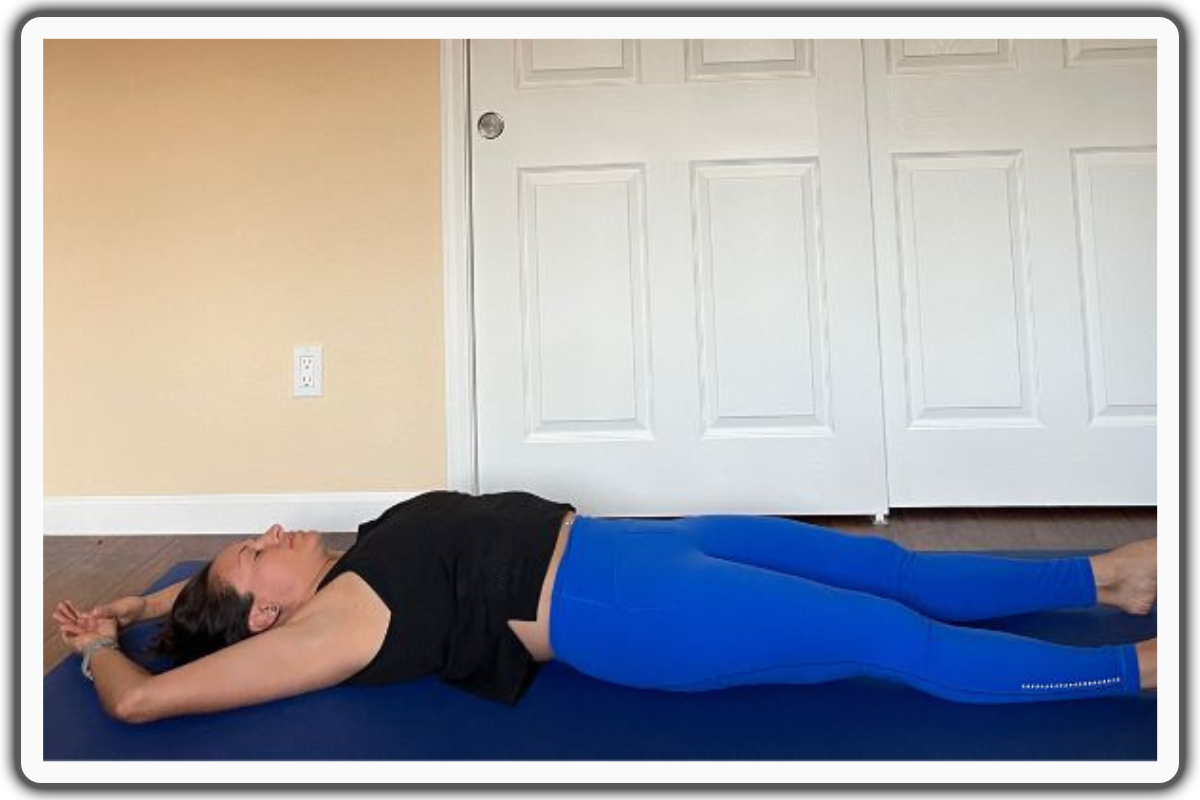
Lie on your back on the floor, maintaining good alignment with your head, shoulders, hips, and legs. Engage your core and reach both arms overhead as you straighten your legs straight, stretching your back. Hold this position for several deep belly breaths, in through your nose and then out through your mouth.
3. Lying Side Bend
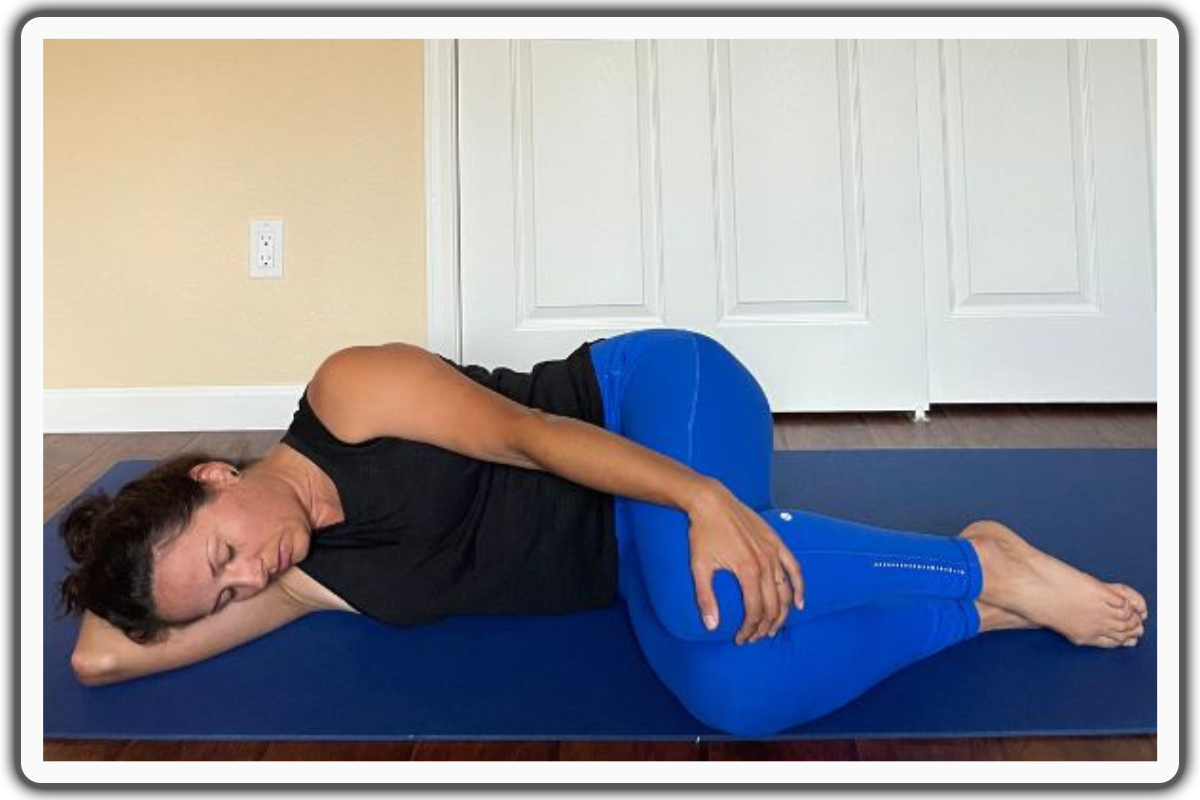
Lie on your side with your head resting on your outstretched arm, keeping your shoulders, hips, and legs in alignment. Engage your core and bring both knees towards your chest. Hold this position for several deep belly breaths, in through your nose and then out through your mouth. Repeat the movement on the opposite side.
Remember that the idea is to relax, so you don't have to focus on the poses themselves. All of these should be painless. If you have a health condition, you should talk to your doctor before practicing yin yoga For beginners.
Incorporating Mindfulness and Meditation in Yin Yoga Practice
Mindfulness and meditation play an integral role in the practice of Yin Yoga. As you settle into a Yin pose, take the opportunity to observe any sensations, thoughts, or emotions that arise without judgment or attachment. Allow yourself to be fully present in the moment, cultivating deep awareness and acceptance.
One way to enhance mindfulness in your Yin Yoga practice is to focus on breathing. As you hold a pose, bring your breath awareness and your attention to the natural rhythm of your breath. Notice the feeling of the breath entering and leaving your body, and allow it to guide you deeper into relaxation.
Furthermore, another powerful technique to incorporate into your Yin Yoga practice is meditation. After setting into a pose, you can close your eyes and bring awareness to a specific focus point, such as the breath, a mantra, or a visual image. This meditation can help calm the mind, reduce mental chatter, and deepen the sense of relaxation.
For Stress Relief Relaxation
In today's fast-paced world, stress has become an everyday companion for many. Fortunately, Yin Yoga offers a gentle and effective way to counteract the effects of stress and promote relaxation. Through its slow, meditative approach, Yin Yoga activates the parasympathetic nervous system, allowing the body to rest deeply.
The long holds in Yin Yoga poses provide an opportunity to release physical tension and tightness stored in the body. As you surrender to stillness and observe sensations in the body, you may notice a gradual release of stress and a sense of ease washing over you. Yin Yoga encourages the body to let go and invites deep relaxation into every cell.
Additionally, Yin Yoga can help to calm the mind and reduce mental stress. Practitioners can develop greater clarity and peace by cultivating mindfulness and present-moment awareness. The practice becomes a sanctuary where you can let go of worries, fears, and anxieties, allowing for a renewed sense of balance and tranquility.
How to Create a Yin Routine
Create a Yin Yoga routine that suits your needs and schedule is a beautiful way to incorporate the practice into your daily life. Here are some tips to help you create a personalized Yin Yoga routine:
- Set aside dedicated time - Choose a time of day when you can commit to a Yin Yoga practice without interruptions. This could be early morning, before bed, or any other time that works best for you.
- Create a sacred space - Designate a quiet and clutter-free space in your home where you can practice Yin Yoga. Decorate it with candles, incense, or other elements that create a sense of peace and tranquility.
- Choose a selection of poses - Select a variety of Yin Yoga poses that target different areas of the body. Aim for a well-rounded practice that includes hip, spine, shoulders, and leg postures.
- Start with shorter holds - If you are new to Yin Yoga, begin with more temporary holds, around one to three minutes, and gradually increase the duration as your body becomes more comfortable with the practice.
- Listen to your body - Always listen to your body and adjust the poses as needed. Yin Yoga should never cause pain or discomfort if a pose feels too intense. Back off or use props for support.
- Include mindfulness and meditation - Integrate mindfulness and meditation techniques into your Yin Yoga routine to enhance the relaxation and reflective aspects of the practice.
Remember, consistency is vital when establishing a Yin Yoga routine. Start with a realistic commitment, even if it's just a few minutes each day, and gradually increase the duration as your practice evolves.
Props and Equipment
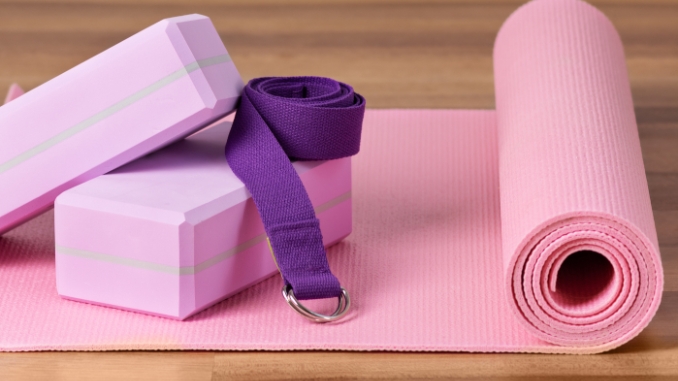
Yin Yoga can be practiced with minimal props and equipment, but specific props can enhance your practice and provide additional support. Here are some standard props used in Yin Yoga classes:
- Yoga mat : A non-slip yoga mat provides stability and cushioning during your Yin Yoga practice. Choose a mat that feels comfortable and supportive.
- Yoga blocks: Blocks can be used to provide support to your body in poses where flexibility is limited. They can be placed under the hands, forearms, or sit bones for additional height and stability.
- Yoga bolster: A bolster is a long, firm pillow that can support the body in reclining poses, such as a passive butterfly or supported bridge. It helps to create a sense of relaxation and ease in the body.
- Blankets: Blankets can be folded and used as props to provide support and cushioning for the body in various poses. They can also cover the body during the final relaxation pose, savasana, to provide warmth and comfort. particularly for your left leg and left hip.
- Straps: Yoga straps can increase accessibility and support in certain poses. They can be looped around the feet, legs, or arms to help maintain proper alignment and prevent strain or injury, particularly for your right and left ankle.
Remember, props are optional and should be used to enhance your comfort and safety in the poses. Experiment with props, and practice what works best for your body.
Conclusion
As we conclude this comprehensive beginner's guide to Yin Yoga, we hope you have gained a deeper understanding and appreciation for this gentle practice. Yin Yoga offers a unique opportunity to slow down, cultivate mindfulness, and profoundly nurture the body and mind for physical and mental benefits.
By surrendering to stillness and exploring gentle poses for an extended period, you can experience a profound release of tension and a heightened sense of peace. Yin Yoga allows you to tap into your inner wisdom, embrace the present moment, and find balance in an increasingly fast-paced world.
Whether you are a seasoned yogi looking to widen your practice or a beginner seeking relaxation and flexibility, Yin Yoga is a path worth exploring. Step onto the mat, take a deep breath and allow Yin Yoga to guide you toward a more profound sense of self-discovery, tranquility, and well-being.
Remember, Yin Yoga is a journey; each practice is an opportunity to deepen your understanding and connection with yourself. Embrace the gentle path of Yin Yoga and let its transformative power unfold in your life.
